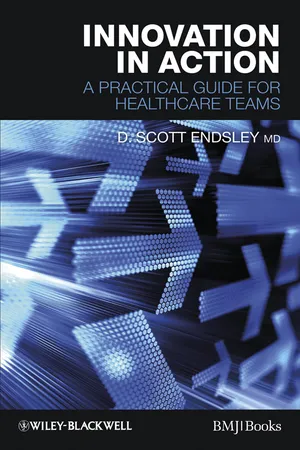
- English
- ePUB (mobile friendly)
- Available on iOS & Android
About this book
It is now recognized that innovation in healthcare needs to be a primary strategy for dealing with the challenges of pressure from consumers and the effort to control costs.This practical guide describes key issues surrounding innovation, such as the barriers to innovation in healthcare, the opportunities of working across boundaries in open innovation, and the process and tools of exploring the innovation approach.
The highly-regarded author follows a five-stage process model that presents a systematic base for understanding, and -- more importantly -- performing innovation work:
1. Defining the innovation design challenge
2. The process and tools of exploring the innovation
3. Generating innovative ideas
4. Prototyping and testing innovations
5. Creating a diffusion plan
This user-friendly guide is ideal for all healthcare professionals and healthcare teams, both in training and in practice.
Frequently asked questions
- Essential is ideal for learners and professionals who enjoy exploring a wide range of subjects. Access the Essential Library with 800,000+ trusted titles and best-sellers across business, personal growth, and the humanities. Includes unlimited reading time and Standard Read Aloud voice.
- Complete: Perfect for advanced learners and researchers needing full, unrestricted access. Unlock 1.4M+ books across hundreds of subjects, including academic and specialized titles. The Complete Plan also includes advanced features like Premium Read Aloud and Research Assistant.
Please note we cannot support devices running on iOS 13 and Android 7 or earlier. Learn more about using the app.
Information
CHAPTER 1
Introduction to innovation
- Aim for simplicity
- Think in verbs, not nouns
- Build on ideas of others
- Create an idea “treasure box”
- Think both spatial as well as process change
- Brainstorm often
- Bring people together
What is innovation?
- Awareness: Ability to perceive opportunities, distinguishing them from your own agenda, ability to overcome cognitive blindness
- Focus and persistence: Ability to maintain attention on innovation challenge amidst chaos and obstacles
- Listening and synthesizing: Ability to hear others ideas, needs, preferences, and to blend them together with your own to create new ideas
- Declarations: Ability to make simple, powerful, moving, eloquent statements about the future that serve as attractors for others
- Destiny: A sense of the future and of possibilities that is powered by a larger purpose
- Offers: Bring value to your customers and stakeholders. Ability to deliver with commitment to results
- Networks and allies: Ability to build and maintain productive relationships with others, especially representing different perspectives and skills
- Learning: Constantly seeking new ideas, skills, and experiences from traditional and nontraditional sources; a mindset of inquiry
Why is innovation so hard in healthcare
Table of contents
- Cover
- Table of Contents
- Title
- Copyright
- Foreword
- Chapter 1: Introduction to Innovation
- Chapter 2: Defining the Innovation Challenge
- Chapter 3: The Deep Dive
- Chapter 4: Generating Innovative Ideas
- Chapter 5: Prototyping and Testing Ideas
- Chapter 6: Creating Your Diffusion Plan
- Appendix
- Index
- End User License Agreement